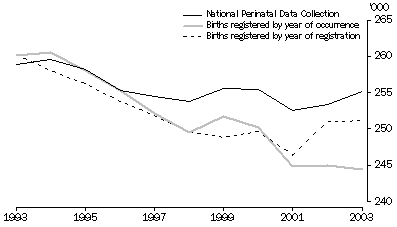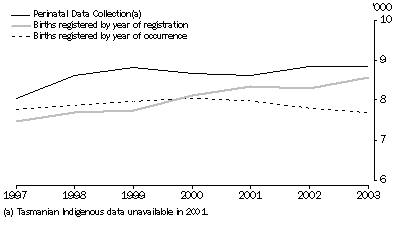APPENDIX 1 DIFFERENCES BETWEEN COLLECTIONS
BIRTH REGISTRATIONS COMPARED TO THE PERINATAL DATA COLLECTION
Birth registration data in this publication are not the only births data available in Australia. The National Perinatal Statistics Unit of the Australian Institute of Health and Welfare (AIHW) also collects birth data from midwives and other health professionals who attend births. This data is published annually in Australia's Mothers and Babies.
As information from these two types of collection are from different sources, the statistics obtained vary. For example, the Perinatal Data Collection reported the occurrence of 255,100 live births in Australia in 2003 (the latest available data), 1.6% more than the 251,200 births registered in the same year.
The following graph shows the total number of live births in Australia by type of collection and recording basis from 1993 to 2003. Births from the Perinatal Data Collection are shown on a year of occurrence basis. Registered births are shown on a year of registration basis and on a year of occurrence basis, which includes births that occurred in a particular year but may have been registered up to and including the year 2005. Prior to 1994, the Perinatal Data Collection showed fewer births than births registered. Since then this position has reversed, with the gap between births reported in the Perinatal Data Collection and births registered widening until 1999 (when there were 3% more births recorded in the Perinatal Data Collection than births registered). This figure has declined since 1999, to 1.6% in 2003. While difficult to explain, the change in pattern may be due to improvements in quality and coverage of the Perinatal Data Collection, particularly with the introduction of a perinatal National Minimum Dataset (NMDS) in 1997 which developed national standards for the collection of perinatal statistics. The trends also reflect changing propensities of parents to delay or fail to register the birth of a child. For birth registration data, the proportion of births occurring and being registered in the same year declined from 90% in 1993 and 1994 to a low of 86% in 2002, and has since risen to 89% in 2005.
A2.1 live births, Type of collection

The following analysis of the difference between the type of collections is made on live births between the Perinatal Data Collection on a year of occurrence basis and the Birth Registrations collection on a year of registration basis.
AGE OF MOTHER
Age of mother is a factor which contributes to differences between the Perinatal Data Collection and birth registration data. In 2003, a higher number of confinements were recorded in the Perinatal Data Collection than in births registrations for mothers in all age groups. For mothers aged 19 years and under, the number of confinements recorded in the Perinatal Data Collection outnumbered births registered by 7.5% in 2003, declining with increasing age to one per cent for mothers aged 35-39 years.
A2.2 Confinements, Difference between collections by age of mother - 2003(a) |
|  |
 | Perinatal Data Collection | Birth Registrations | Difference(b) |  |
 | no. | no. | % |  |
|  |
| 19 years and under | 11 617 | 10 743 | 7.5 |  |
| 20-24 years | 37 509 | 35 913 | 4.3 |  |
| 25-29 years | 70 233 | 68 613 | 2.3 |  |
| 30-34 years | 85 750 | 84 460 | 1.5 |  |
| 35-39 years | 39 443 | 39 036 | 1.0 |  |
| 40 years and over | 8 000 | 7 871 | 1.6 |  |
| Total(c) | 252 584 | 247 089 | 2.2 |  |
|  |
| (a) Year of occurrence for Perinatal Data Collection and year of registration for Birth Registrations collection. |
| (b) Positive figures denote more confinements recorded in the Perinatal Data Collection than the Birth Registrations collection. |
| (c) Includes age of mother not stated. |
STATE AND TERRITORY COMPARISONS
While birth registrations data provides information on state/territory of registration or state/territory of usual residence of mother, the Perinatal Data Collection only provides data on the state/territory in which the birth took place (that is, the state/territory of occurrence). The following analysis therefore compares state/territory of usual residence from birth registrations to state/territory of occurrence from the Perinatal Data Collection. As a small number of births occur in a different state or territory to that of the mother's usual residence, there are some minor differences. For example, some women living in rural New South Wales close to the Australian Capital Territory have their babies in Canberra. As a consequence, the Australian Capital Territory has been excluded from the comparisons below.
In 2003, the Perinatal Data Collection recorded more births in Victoria, Queensland, South Australia and Western Australia, while there were more births registered in New South Wales, Tasmania and the Northern Territory.
A2.3 Live births, Type of collection by state/territory - 2003(a) |
|  |
 | NSW | Vic. | Qld | SA | WA | Tas. | NT | Total(b) |  |
|  |
| Perinatal Data Collection (no.) | 85 891 | 63 018 | 50 059 | 17 710 | 24 497 | 5 482 | 3 621 | 255 099 |  |
| Birth Registrations (no.) | 86 344 | 61 058 | 48 342 | 17 443 | 24 273 | 5 752 | 3 790 | 251 161 |  |
| Difference (%)(c) | -0.5 | 3.1 | 3.4 | 1.5 | 0.9 | -4.9 | -4.7 | 1.5 |  |
|  |
| (a) State and year of occurrence for Perinatal Data Collection, and state of usual residence and year of registration for Birth Registrations collection. |
| (b) Includes Australian Capital Territory and Other Territories. |
| (c) Positive figures denote more births recorded in the Perinatal Data Collection than the Birth Registrations collection. |
BIRTHS TO INDIGENOUS MOTHERS
There are differences between Indigenous data from the Perinatal Data Collection and Indigenous birth registrations data. In all years from 1997 to 2003 the number of births to Indigenous mothers as recorded in the Perinatal Data Collection exceeded registered births to Indigenous mothers. For 2003 there were 8,900 live births to Indigenous mothers recorded in the Perinatal Data Collection, 300 more (3%) than the number recorded by birth registrations (8,600).
It is important to recognise that data concerning Indigenous status is affected by identification issues. Differences between the Perinatal Data Collection and birth registrations data may in part be due to low coverage of registrations of Indigenous births (for example, the coverage of registered Indigenous births, where at least one parent identified as being of Indigenous origin, was estimated at 95% for the period 2001-2005). However, failure to determine Indigenous status may also affect the Perinatal Data Collection. As a result, caution should be used when interpreting Indigenous births data from either source. Paragraphs 14 to 20 of the Explanatory Notes provide further information about coverage of Indigenous birth registrations.
A2.4 live births to indigenous mothers, Type of collection

 Print Page
Print Page
 Print All
Print All